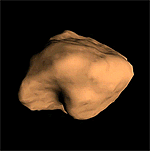Uing powerful radar observations to produce strikingly detailed images, scientists are just beginning to reveal the menagerie of potentially hazardous near-Earth asteroids (NEAs). A team led by Steven Ostro of the Jet Propulsion Laboratory (JPL) in Pasadena, California, combined the radar muscle of the Arecibo telescope in Puerto Rico with NASA’s Deep Space Network antenna in California. The asteroid echoes the group has captured reveal surface details as small as tens of meters. To obtain a similar resolution with optical telescopes would require mirrors hundreds of meters across.
Snapping a series of ghostly images over time allowed the researchers to determine the spin rate of each asteroid. This technique also enabled them to produce geologically detailed three-dimensional models of each object. Over 230 asteroids have been studied with radar so far, and the emerging picture shows a surprisingly diverse set of objects. Their sizes and rotation periods vary by a factor of 10,000, while their composition ranges from stony to metallic, and shapes run from “nearly featureless spheroids” to highly elongated bodies. At the smallest scales, say the scientists, NEAs can be smoother than the powdery surface of our Moon or rougher than the rockiest terrain on Mars.
This detailed radar reconnaissance not only will be used as an early detection system for Earth-orbit crossers, but also will benefit directly any robotic or manned missions to asteroids planned for the near future. The team presented its findings at the 2004 Joint Assembly of the American and Canadian Geophysical Unions, held this week in Montreal, Canada.











